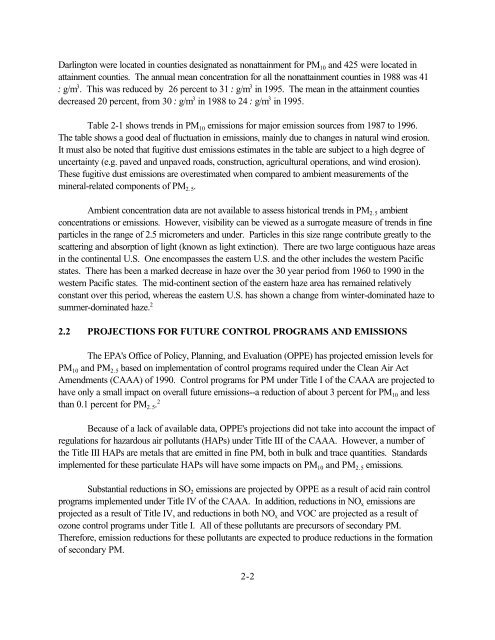Stationary Source Control Techniques Document for Fine Particulate ...
Stationary Source Control Techniques Document for Fine Particulate ...
Stationary Source Control Techniques Document for Fine Particulate ...
Create successful ePaper yourself
Turn your PDF publications into a flip-book with our unique Google optimized e-Paper software.
Darlington were located in counties designated as nonattainment <strong>for</strong> PM 10 and 425 were located in<br />
attainment counties. The annual mean concentration <strong>for</strong> all the nonattainment counties in 1988 was 41<br />
:g/m 3 . This was reduced by 26 percent to 31 :g/m 3 in 1995. The mean in the attainment counties<br />
decreased 20 percent, from 30 :g/m 3 in 1988 to 24 :g/m 3 in 1995.<br />
Table 2-1 shows trends in PM 10 emissions <strong>for</strong> major emission sources from 1987 to 1996.<br />
The table shows a good deal of fluctuation in emissions, mainly due to changes in natural wind erosion.<br />
It must also be noted that fugitive dust emissions estimates in the table are subject to a high degree of<br />
uncertainty (e.g. paved and unpaved roads, construction, agricultural operations, and wind erosion).<br />
These fugitive dust emissions are overestimated when compared to ambient measurements of the<br />
mineral-related components of PM 2.5.<br />
Ambient concentration data are not available to assess historical trends in PM 2.5 ambient<br />
concentrations or emissions. However, visibility can be viewed as a surrogate measure of trends in fine<br />
particles in the range of 2.5 micrometers and under. Particles in this size range contribute greatly to the<br />
scattering and absorption of light (known as light extinction). There are two large contiguous haze areas<br />
in the continental U.S. One encompasses the eastern U.S. and the other includes the western Pacific<br />
states. There has been a marked decrease in haze over the 30 year period from 1960 to 1990 in the<br />
western Pacific states. The mid-continent section of the eastern haze area has remained relatively<br />
constant over this period, whereas the eastern U.S. has shown a change from winter-dominated haze to<br />
summer-dominated haze. 2<br />
2.2 PROJECTIONS FOR FUTURE CONTROL PROGRAMS AND EMISSIONS<br />
The EPA's Office of Policy, Planning, and Evaluation (OPPE) has projected emission levels <strong>for</strong><br />
PM 10 and PM 2.5 based on implementation of control programs required under the Clean Air Act<br />
Amendments (CAAA) of 1990. <strong>Control</strong> programs <strong>for</strong> PM under Title I of the CAAA are projected to<br />
have only a small impact on overall future emissions--a reduction of about 3 percent <strong>for</strong> PM 10 and less<br />
than 0.1 percent <strong>for</strong> PM 2.5. 2<br />
Because of a lack of available data, OPPE's projections did not take into account the impact of<br />
regulations <strong>for</strong> hazardous air pollutants (HAPs) under Title III of the CAAA. However, a number of<br />
the Title III HAPs are metals that are emitted in fine PM, both in bulk and trace quantities. Standards<br />
implemented <strong>for</strong> these particulate HAPs will have some impacts on PM 10 and PM 2.5 emissions.<br />
Substantial reductions in SO 2 emissions are projected by OPPE as a result of acid rain control<br />
programs implemented under Title IV of the CAAA. In addition, reductions in NO x emissions are<br />
projected as a result of Title IV, and reductions in both NO x and VOC are projected as a result of<br />
ozone control programs under Title I. All of these pollutants are precursors of secondary PM.<br />
There<strong>for</strong>e, emission reductions <strong>for</strong> these pollutants are expected to produce reductions in the <strong>for</strong>mation<br />
of secondary PM.<br />
2-2

















